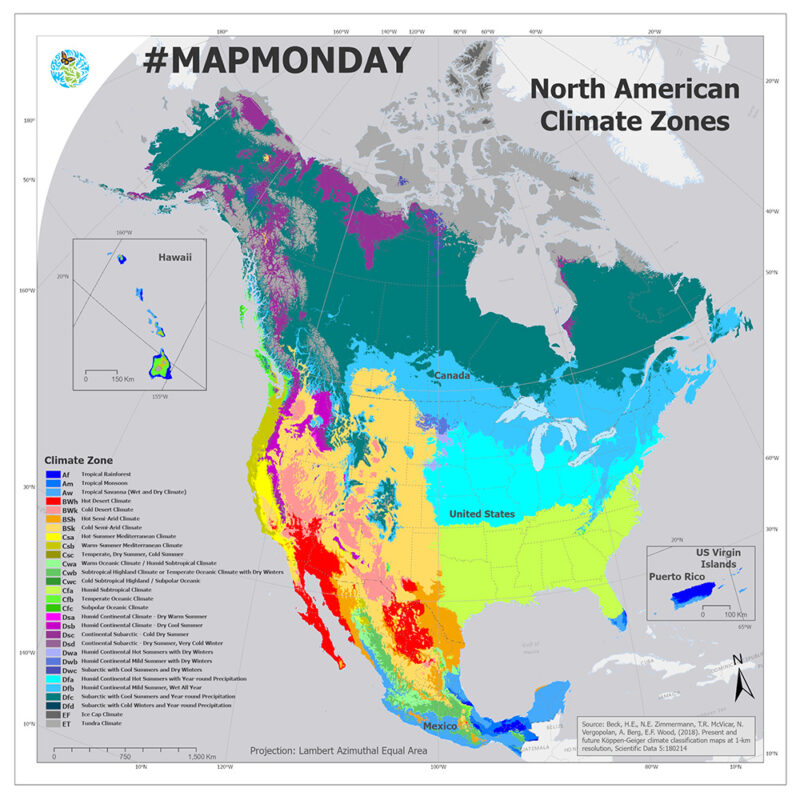North America is a vibrant tapestry of climate zones, each one intricately woven with its own distinct characteristics and nuances. This geographical mosaic spans vast distances, showcasing everything from arid deserts to lush temperate forests. Understanding these climate zones is crucial, not only for the ecological balance but also for the socio-economic landscapes that emerge within them.
The United States and Canada, along with parts of Mexico, fall under the intricate umbrella of North American climate classifications. This diverse region can be metaphorically likened to a finely aged wine, each climate zone contributing unique flavors and complexity to the broader environmental palette. In this article, we will delve into the intricacies of North America’s climate zones, exploring their formation, unique features, and the implications they hold for environmental sustainability.
1. The Arctic Tundra: Earth’s Frigid Expanse
Picture a vast, frozen landscape where the ground is perpetually cloaked in snow and ice. The Arctic tundra represents the coldest climate zone in North America. Located primarily in northern Canada and Alaska, this environment is characterized by sub-zero temperatures, particularly during winter. The vegetation here is scarce, limited to low-lying mosses, lichens, and a few hardy shrubs. The ecological significance is profound; the tundra plays a crucial role in regulating the planet’s temperature and houses unique species such as the Arctic fox and caribou. However, climate change poses threats to this delicate ecosystem, as rising temperatures accelerate permafrost melt, which can release significant amounts of greenhouse gases into the atmosphere.
2. Boreal Forest: The Resilient Green Shield
Descending southward, one encounters a striking transition into the boreal forest zone. Stretching across Canada, parts of Alaska, and into the northern reaches of the contiguous United States, this biome forms a verdant shield characterized by coniferous trees like spruce and fir. The boreal forest is often viewed as the lungs of the Earth; its trees absorb carbon dioxide, producing oxygen crucial for maintaining atmospheric balance. Here, the tumultuous cycles of freezing winters and mild summers craft an environment rich in biodiversity. Species such as moose, bears, and lynxes find sanctuary in this resilient sanctuary. However, this precious biome is increasingly threatened by logging and the encroachment of industrial agriculture.
3. Temperate Forest: A Symphony of Seasons
As one travels further south, the climate embraces a more temperate persona, giving rise to the temperate forest zone. This region is a quintessential illustration of seasonal change, where warm summers segue into colorful autumns and frigid winters. Stretching across much of the eastern United States, the temperate forests are teeming with broadleaf trees such as oaks, maples, and hickories, creating a rich understory filled with shrubs and wildflowers. The biodiversity here is staggering; countless bird species, deer, and smaller mammals thrive in this intricate ecosystem. However, urban expansion and habitat destruction pose substantial threats to these forests, emphasizing the imperative for conservation efforts.
4. Grasslands: The Gentle Giants
Transitioning into the expansive grasslands, one encounters landscapes that rise and fall like ocean waves, punctuated by prairie grasses swaying in the breeze. This zone, often referred to as prairies or savannas, can be found throughout central North America. Grasslands are critical for agriculture, supporting vast crop production and livestock grazing. They are habitats for a diverse array of wildlife, including bison, prairie dogs, and a variety of bird species. Yet, these ecosystems have been severely impacted by human activity, with a substantial portion converted for agricultural use. The preservation of grasslands is not merely an environmental concern but is vital for maintaining biodiversity.
5. Desert: The Enigmatic Drylands
As one travels further southwest, the climate transforms dramatically into arid deserts. The Sonoran and Mojave Deserts in the southwestern United States exemplify this starkly beautiful zone. With extreme temperatures and minimal precipitation, deserts present a formidable environment where life persists against the odds. Cacti and succulents paint the landscape with bursts of life, while specialized fauna such as rattlesnakes and roadrunners have adapted to the harsh conditions. Desert ecosystems are exquisitely balanced, yet they face significant pressures from urban development and climate change, highlighting the urgent need for sustainable practices.
6. Mediterranean Climate: A Unique Blend
Lastly, one cannot overlook the Mediterranean climate, prevalent along California’s coast. This unique climatic zone, characterized by wet winters and dry summers, fosters diverse ecosystems, including oak woodlands and coastal sage scrub. The lush vineyards and orchards thrive in this climate, contributing not only to local economies but also to global agricultural markets. However, prolonged droughts, exacerbated by climate change, threaten the sustainability of this rich resource, demanding thoughtful water management and conservation measures.
Conclusion
In essence, North America’s climate zones are not merely environmental boundaries; they are vibrant, living entities that reflect the interplay between the earth’s natural forces and human influence. Each zone offers lessons in resilience and adaptability, underscoring the interconnectedness of our ecosystems. As we address the challenges posed by climate change, understanding these diverse climates becomes imperative, fostering a collective responsibility to protect the natural heritage that sustains us all.
These climatic intricacies form the backdrop against which humanity thrives. By safeguarding their future, we honor the intricate dance of life that unfolds in North America’s remarkable climate zones.
